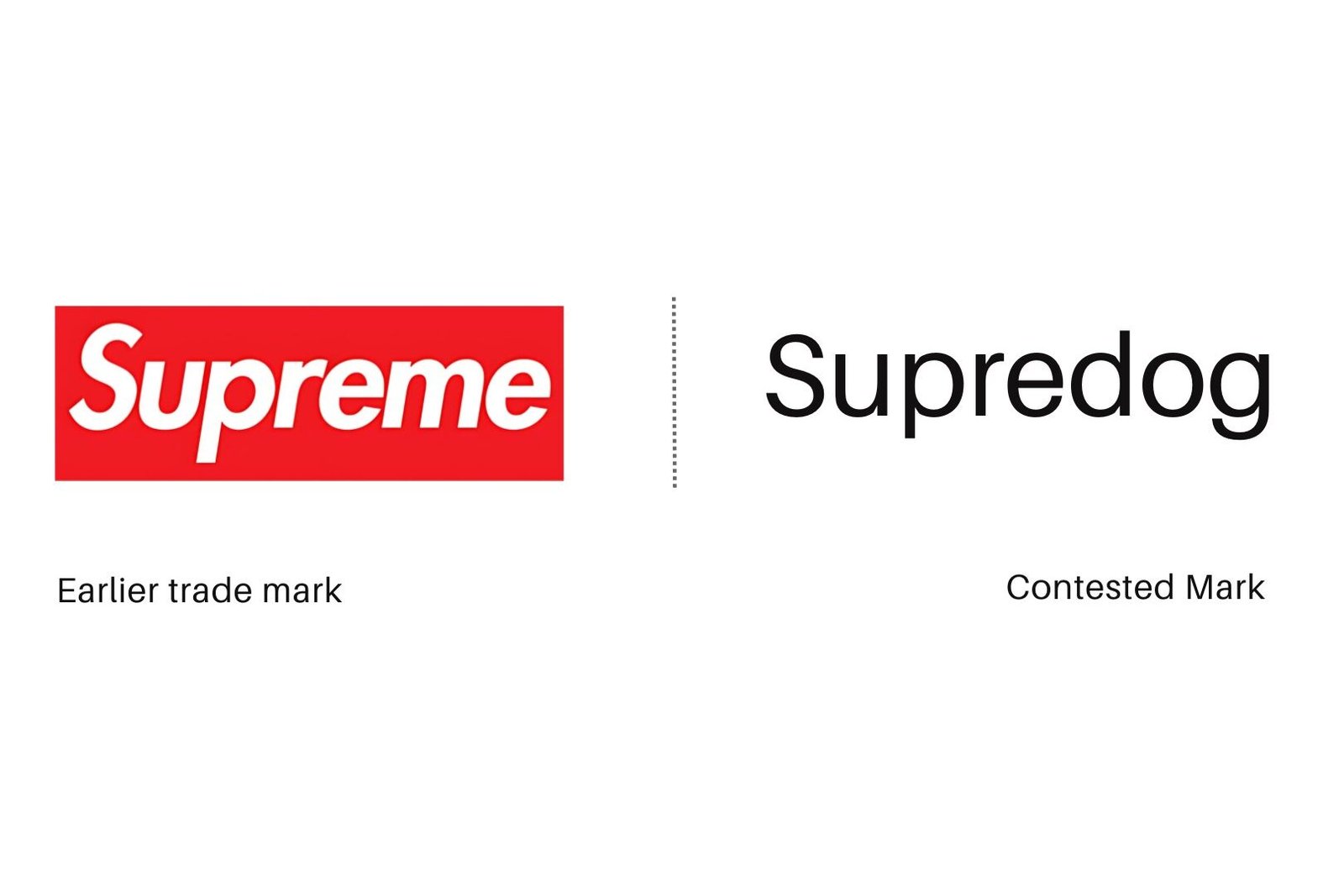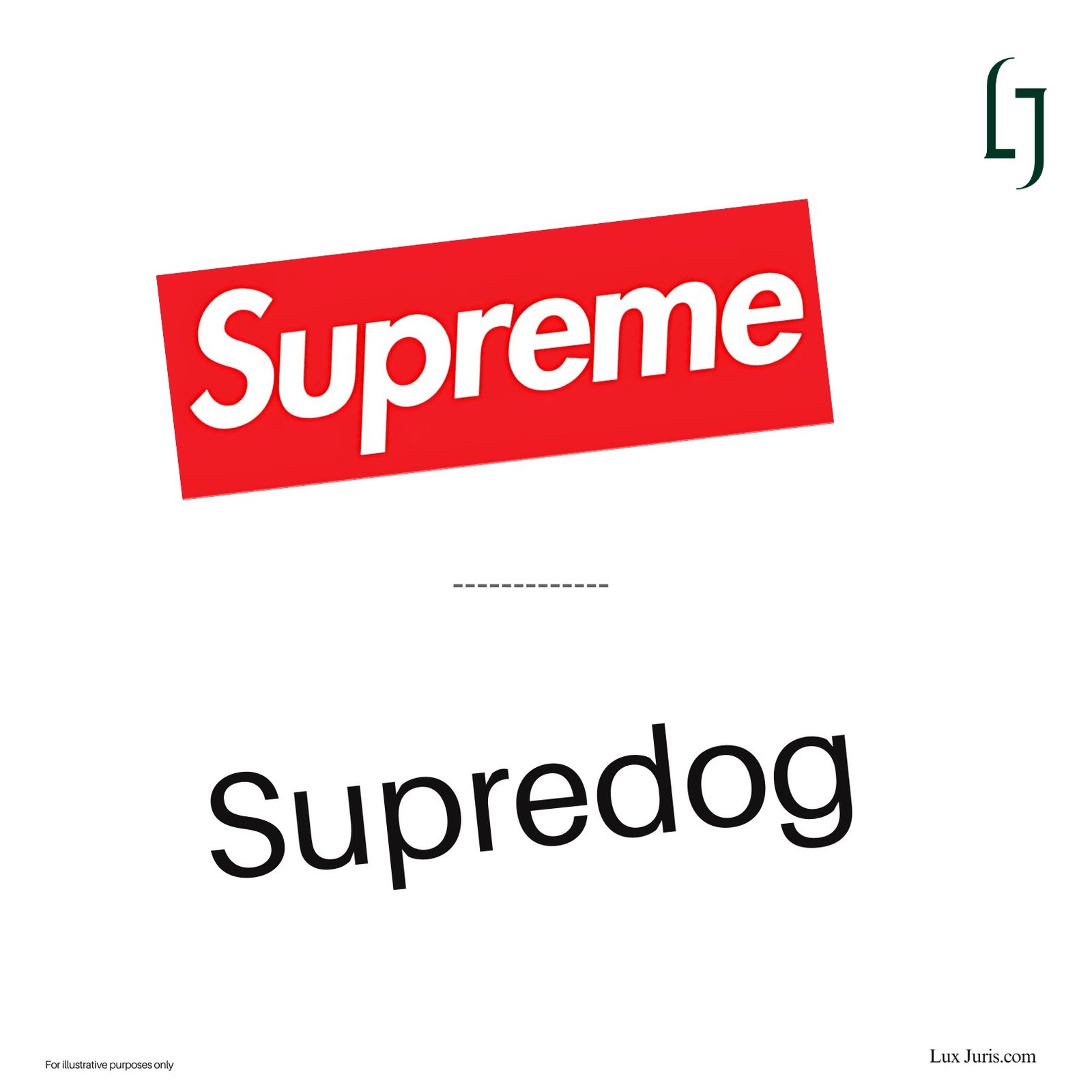On 11 June 2025, the European Union Intellectual Property Office cancelled the word mark ‘Supredog’ following an invalidity application by Chapter 4 Corp., the company behind SUPREME. The Cancellation Division found that the contested mark was too closely aligned with the earlier SUPREME figurative mark and that its continued use would unfairly benefit from the reputation attached to Supreme’s brand.
This outcome supports Supreme’s enforcement efforts across non-traditional product categories and confirms that trademark protection may extend beyond core goods when reputation is well established and substantiated.
The SUPREME Trademark Invalidation Request
The invalidity application was filed against the word mark ‘Supredog’, registered by Jiaozuo Nanyu Trading Co., Ltd. for pet-related products in Class 18. These included collars, leashes, raincoats, and clothing for pets. Supreme relied on its earlier figurative mark featuring the word ‘Supreme’ in white italic letters on a red background.
The applicant claimed that the term ‘Supredog’ adopted the dominant prefix ‘Supre’, identical to the start of its own mark. The final component, ‘dog’, was viewed as descriptive and weak in distinctiveness for the contested goods. Supreme also submitted evidence that the ‘Supredog’ mark had been used in a stylised manner imitating the visual identity of the SUPREME brand, including the same red background and italic font.
Evidence of Reputation and Market Presence
To support the invalidation request, Supreme submitted extensive documentation establishing its reputation across the European Union, with particular focus on Italy. The evidence covered commercial activity through online and in-store sales, long-standing brand visibility, media coverage, and collaborations with companies such as Louis Vuitton, Nike, and The North Face.
Sales records, media articles, and product catalogues demonstrated that Supreme had used its mark across a broad range of goods. These extended far beyond clothing and bags to include accessories, novelty products, and even pet-related items. The brand’s resale value and collector demand were also documented, along with prior court decisions in Italy affirming its well-known status in the fashion sector.
Although the evidence did not include detailed material from 2020 to 2024, the Cancellation Division considered that the earlier reputation was sufficiently strong and ongoing. There was no evidence that this recognition had diminished in the intervening period.
Comparison Between ‘Supredog’ and SUPREME
The Cancellation Division found that the two marks shared the same first syllable, ‘Supre’, which consumers would notice immediately. Given the weak character of the word ‘dog’ in relation to pet products, the shared prefix was considered the most impactful part of the sign.

While the SUPREME mark includes a figurative presentation, the visual style was treated as decorative and secondary to the verbal component. The earlier mark was therefore evaluated primarily on the basis of the word ‘Supreme’.
The marks were found to be visually and aurally similar to a lower-than-average degree. However, due to the prominence of the shared prefix and the reputation of the SUPREME mark, a mental link between the two was considered likely. Supreme’s history of product diversification and co-branded campaigns made it plausible that consumers might believe there was a connection.
Association and Commercial Impact
The Cancellation Division examined whether the contested mark would benefit from the reputation of the SUPREME mark. Supreme provided photographic evidence showing the use of the ‘Supredog’ mark in a format resembling its own. The goods in question included raincoats for dogs featuring a red background and stylised font similar to the applicant’s branding.
Given Supreme’s market position and the distinctive nature of its commercial strategy, which includes releasing unexpected products across different sectors, the Division concluded that the public could reasonably associate the contested goods with the earlier mark. This likelihood was increased by the fact that some of Supreme’s past collaborations included goods directly related to pets and pet accessories.
The result was a finding that the contested mark would derive an unfair benefit from the image, recognition, and value of the SUPREME brand. There was no evidence of independent market presence or legitimate intention from the EUTM proprietor, who also failed to respond during the proceedings.
Outcome of the SUPREME Trademark Invalidation
The EUIPO Cancellation Division declared the ‘Supredog’ mark invalid in its entirety. The decision was based on the finding that the mark would take unfair advantage of the reputation of the earlier SUPREME figurative mark, particularly among consumers in Italy. The relevant goods were close enough in commercial context for the association to arise, especially given the distinctive branding and broad recognition attached to Supreme’s identity.
The invalidation was granted under the provision that protects marks with a reputation, specifically Article 8(5) EUTMR. The Division found that the contested mark imitated the SUPREME name and visual style in a way that could benefit from its established appeal without legitimate justification.
As this ground was sufficient to resolve the matter, the Division did not examine the alternative claims or the allegation that the mark was filed in bad faith.
Conclusion
The ‘Supredog’ mark was cancelled in its entirety as a result of Supreme’s challenge. The outcome was supported by detailed evidence of market reputation, long-term use, and the adoption of a visual and verbal style by the contested mark that closely mirrored the SUPREME brand. The findings showed that the public could be led to associate the two marks, and that the reputation of the earlier mark would be used to the benefit of the later one.
For brands with an established market identity, this case illustrates the scope of protection that may be available when reputation is clearly supported by evidence. Recognition built over time can serve to prevent imitation across adjacent categories, particularly when brand presentation is copied and the intention to associate is apparent.
Source:
